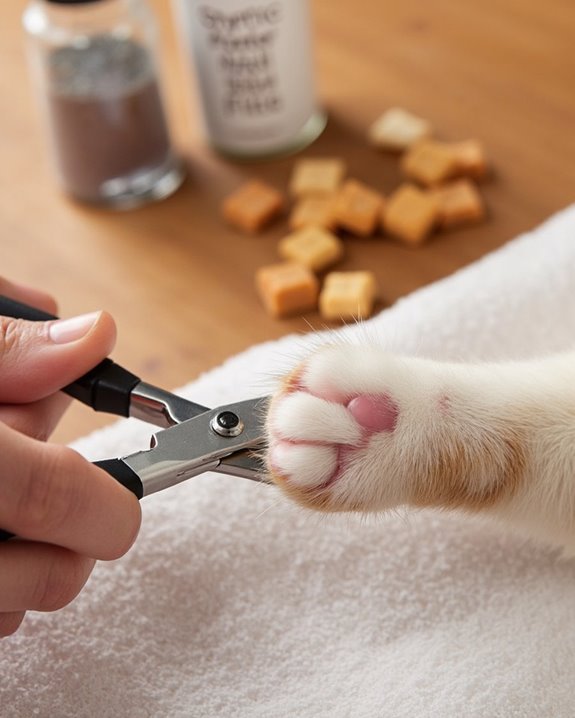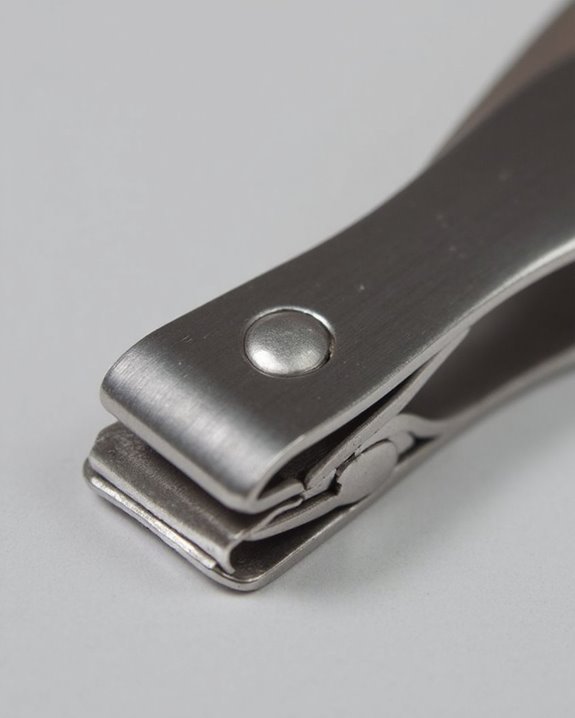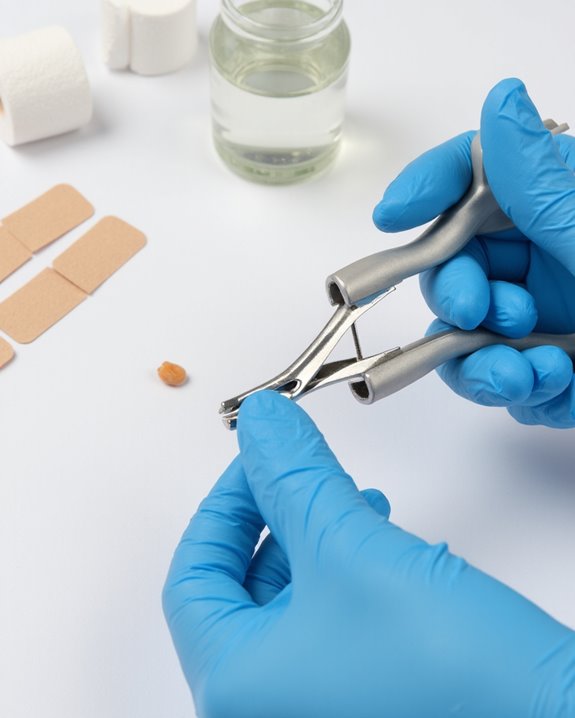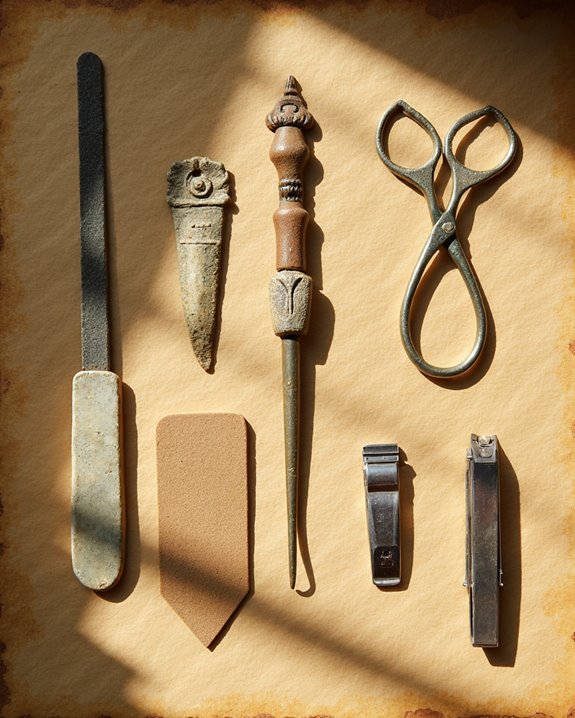You can use dog nail clippers on cats if they’re small to medium-sized and sharp, but exercise caution. Choose scissor-style clippers for better control, and only trim the clear tip to avoid the quick—the sensitive inner portion containing blood vessels. Hold your cat’s paw firmly, press the pad to extend the nail, and cut at a 45-degree angle. For dark nails or anxious cats, cat-specific tools offer more precision and safety during this delicate grooming task.
Key Takeaways
- Dog nail clippers can be used on cats cautiously if they’re small-sized and sharp enough for precise control.
- Scissor-style dog clippers provide better control than guillotine-style when used on cat nails.
- Always trim conservatively, taking only the tip, to avoid cutting the quick which extends further in cat nails.
- Use extra caution with dark-colored cat nails where the quick isn’t visible, making injury risk higher.
- Hold the cat’s paw firmly, press the pad to extend the nail, and cut at a 45-degree angle.
Understanding Cat Nail Anatomy
The anatomy of a cat’s nail requires careful consideration before attempting any trimming procedure. Each of your cat’s nails consists of two main parts: the outer keratin layer that you can see, and the inner quick containing blood vessels and sensitive nerves. When examining your cat’s paw pads, you’ll notice their nails retract when not in use, which is different from dogs. If your cat has light-colored nails, you’ll easily identify the quick as a pinkish area within the nail. However, dark nails make this nearly impossible to see, increasing the risk of cutting into the quick. I recommend trimming only the tip of the nail, staying well away from the quick, which can extend halfway through the nail. Proper understanding prevents painful accidents that cause bleeding and distress to your feline companion. Additionally, using the right grooming tools can make the trimming process safer and more efficient.
Safe Dog Clippers for Cat Nail Trimming
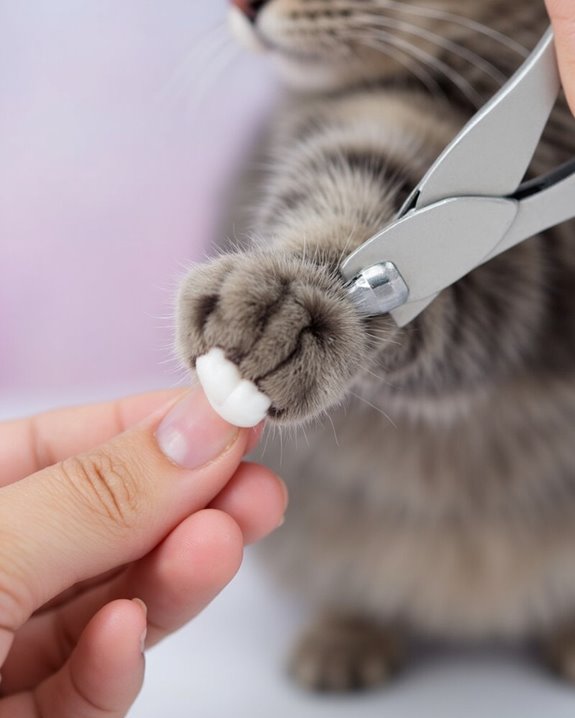
Now that we’ve examined cat nail anatomy, let’s consider which dog nail clippers can safely trim your cat’s delicate claws. I recommend scissor-style clippers specifically designed for smaller animals, as they offer superior control and precision compared to guillotine models. The Safari Professional Nail Trimmer, with its sharp, forged stainless steel blades, delivers clean cuts that won’t split your cat’s nails during trimming. Choosing tools with ergonomic handles can further enhance comfort and safety during the process. Safety features are vital when selecting dog nail clippers for cats. Look for models with built-in stop guides that prevent accidental over-trimming. Additionally, compact tools with dimensions around 3.7 x 2.6 x 0.6 inches, like the Shiny Pet Nail Clippers, provide better maneuverability and stability. These ergonomic, anti-slip handles guarantee a secure grip, reducing the likelihood of errors and making the nail trimming process easier and safer.
Scissor vs. Guillotine Style Clippers for Cats
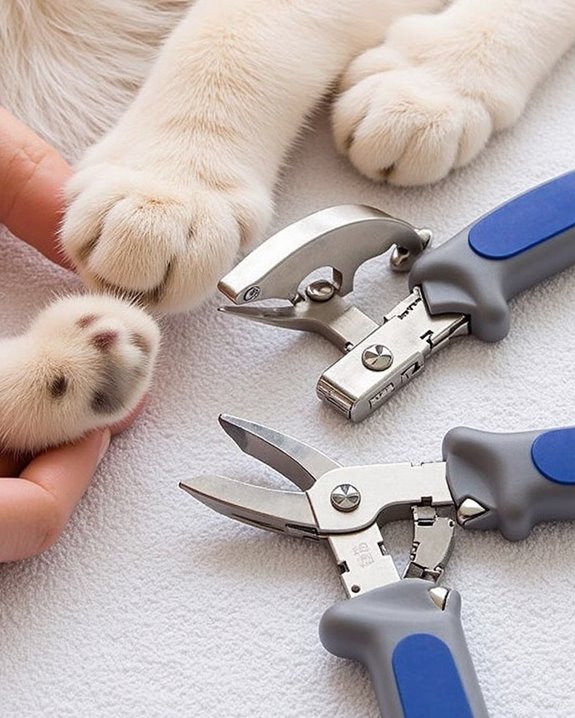
When choosing between scissor and guillotine style clippers for your cat’s nail care, understanding the fundamental differences can greatly impact both your comfort and your pet’s safety during grooming sessions. I’ve found that scissor-style cat nail clippers provide superior control for small nails, functioning like pliers with a more natural cutting motion that reduces the risk of accidentally clipping the quick. The design of the handle mimics regular scissors, creating an ergonomic feel that’s intuitive for most owners.
While guillotine clippers can be easier to cut with for particularly tough nails, they require more careful positioning. The nail must be inserted precisely into the opening before trimming, which demands steady hands. Consider your cat’s nail thickness and your own comfort when selecting between these two effective options.
Preparing Your Cat for Nail Maintenance

Having the right clippers is just one part of successful feline nail care, but preparing your cat mentally and physically for the process will make all the difference in your trimming success. I’ve found that choosing a good time, like when your cat is napping, can help keep stress levels low when using nail clippers designed for pet nails.
If your cat struggles the first time, try recruiting a helper to hold and comfort them, or use the “burrito” blanket technique to gently secure an anxious feline. To make it easier long-term, I recommend desensitizing your cat by gradually introducing the clipper’s sight and sound, even practicing on spaghetti while your cat watches. After each practice session with your cat’s paws, immediately reward them, which will help keep their nails trimmed with minimal fuss in the future.
Step-by-Step Guide to Trimming Cat Nails
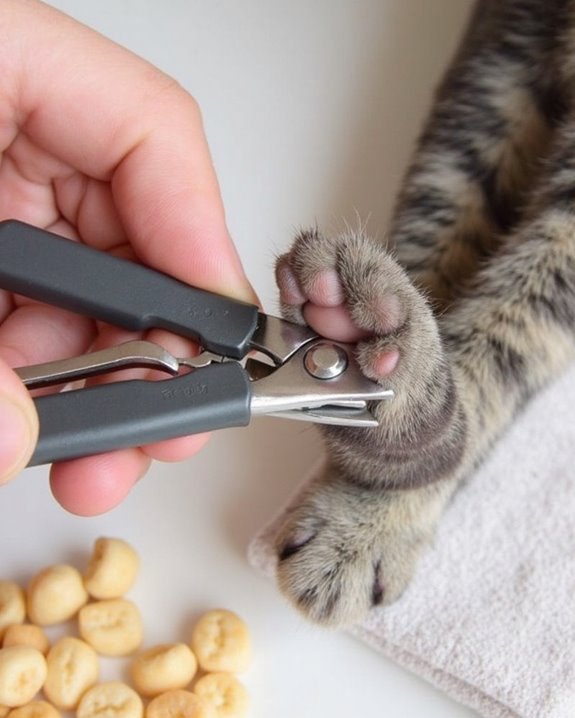
The actual process of trimming your cat’s nails requires patience, precision, and proper technique to guarantee both safety and comfort for your feline friend. I recommend holding your cat’s paw firmly but gently, pressing the pad to extend one nail at a time, then using dog nail clippers on cats at a 45-degree angle. When positioning the nail trimmer, only cut the clear tip, which will help you avoid cutting the quick—the pink area containing blood vessels. If you accidentally cut too deep and cause bleeding, immediately apply styptic powder with gentle pressure to stop the bleeding. I suggest trimming just one or two nails per session if your cat becomes stressed, taking breaks as needed. Remember to trim their nails every few weeks as they regrow.
Avoiding the Quick: Preventing Pain and Bleeding
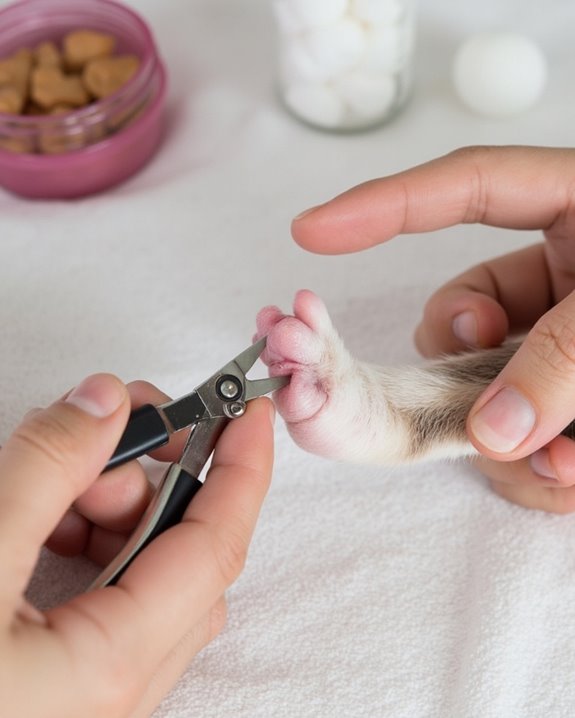
Why do so many cat owners feel anxious about nail trimming? The quick, that sensitive inner part of the nail with blood vessels and nerves, makes them nervous about causing pain or bleeding.
When I use nail clippers on my cats, I always make sure to trim only the clear tip, especially with Dog’s Nail clippers which cuts through the nail with more force. For dark nails where the quick isn’t visible, I take off small amounts at a time to stay safe. Scissor-style clippers with stainless steel blades provide better control than larger models, reducing quick injuries. Clippers designed specifically for precision help prevent splitting, which can lead to quick exposure. If an accident happens, I immediately apply styptic powder to stop bleeding and minimize discomfort.
Managing an Uncooperative Cat During Trims
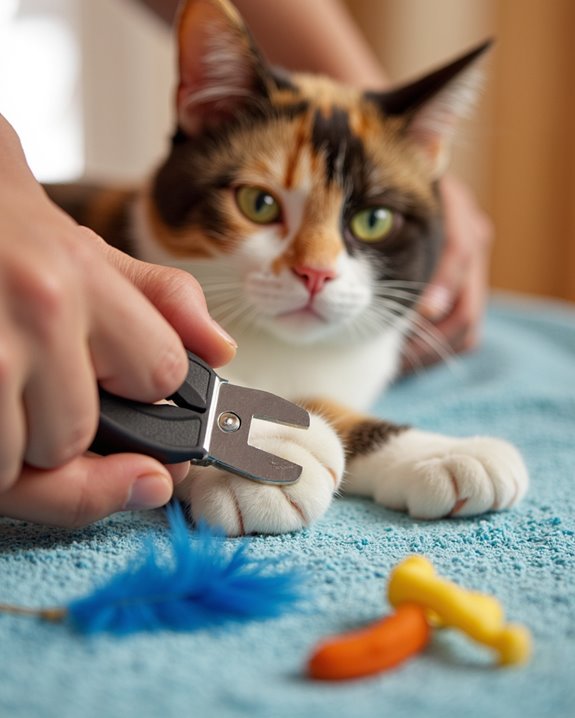
When faced with a squirming, resistant feline, how can you safely trim those sharp little claws without causing stress for both of you? The blanket burrito technique works exceptionally well when using dog clippers on cats, as these animal nail tools are often designed with better grip, making it easier to maintain control. If your cat feels less cooperative, recruit a helper to hold and comfort them while you focus on the nails at home.
Good preparation includes desensitizing your cat to the clippers beforehand, letting them become familiar with the sight and sound before actual use. I recommend trimming just a few nails at a time, giving breaks between each paw, and immediately rewarding your cat after sessions. This systematic approach creates positive associations with the clippers, making future trims much more manageable.
Post-Trimming Care and Rewards
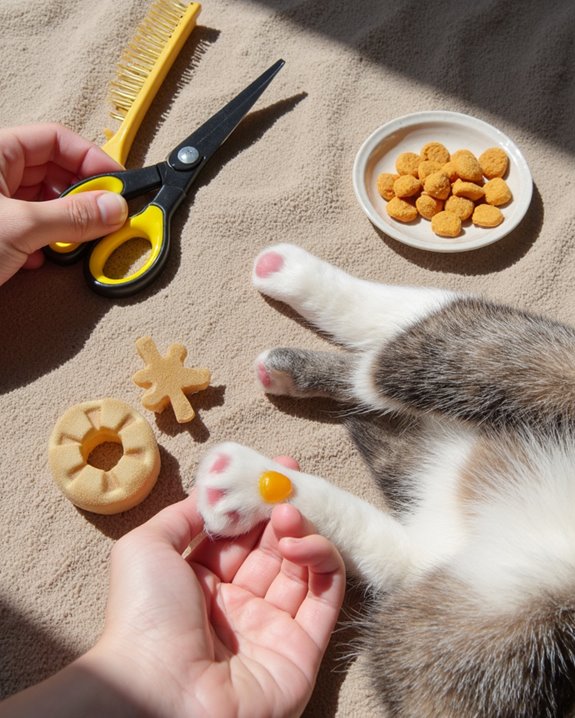
After successfully trimming your cat’s nails with dog clippers, proper post-trimming care becomes essential for both your cat’s health and future grooming sessions. I always apply styptic powder immediately if I accidentally cut the quick, as this information is current and approved by Dr. Feline, a latest veterinarian specialist. It’s a good idea to reward your cat with treats right after getting the job done, creating positive associations that make future sessions easier. I monitor for any bleeding or splitting, applying gentle pressure with a clean cloth if needed. As a lifelong animal lover, I’ve found that providing breaks during the session and ensuring a calm environment afterward are up-to-date in accordance with feline behavioral science, minimizing stress and preventing complications.
Common Mistakes When Using Dog Clippers on Cats
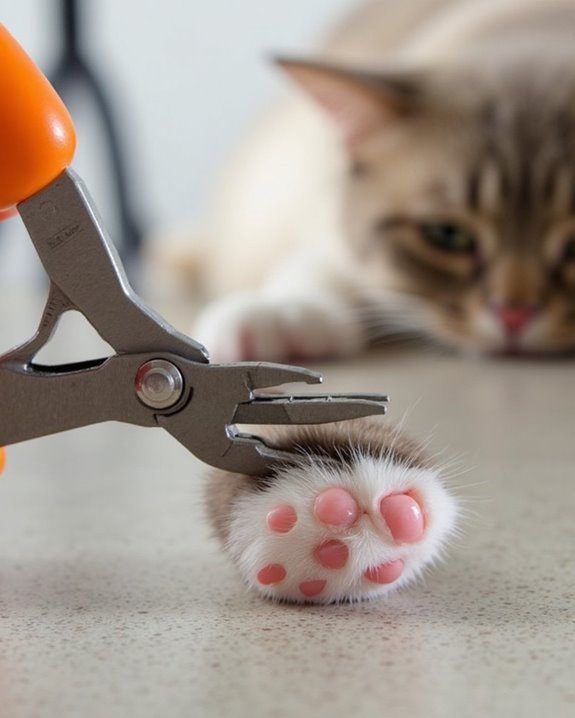
Several critical mistakes can occur when pet owners attempt to use dog nail clippers on their feline companions, often resulting in unnecessary pain or stress for the cat. While clippers can be used for both species, large dog nail trimmers lack the precision needed for cats’ delicate nails. When handles are squeezed too forcefully, oversized clippers may cut too deeply into the quick, causing bleeding and trauma. Even small dog clippers require careful positioning near the blades to guarantee visibility, especially with dark-colored nails where the quick isn’t visible. I’ve found that failing to introduce your cat gradually to the trimming process creates resistance, making positioning difficult. After clipping, always smooth rough edges with a nail file to prevent your cat from catching their claws on fabric or scratching themselves inadvertently. Additionally, choosing a coarse grit nail file designed for pet grooming can help safely smooth out rough edges without causing discomfort.
When to Choose Cat-Specific Nail Tools Instead
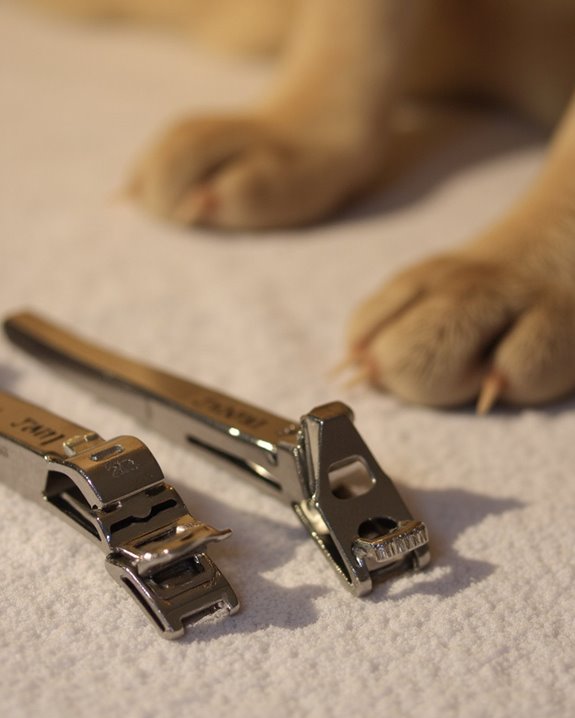
Why should you invest in specialized cat nail trimmers when dog clippers might already be in your pet care arsenal? While dog clippers can work in some situations, cat-specific tools become essential when precision matters most. If dog clippers are too large, they greatly increase the risk of cutting the nail quick, causing pain and bleeding. Cat-specific tools provide better control with scissor-style designs that feel more natural in your hand, reducing injury risk during trimming sessions.
I recommend switching to cat-specific tools when dealing with dark nails where the quick isn’t visible, or when handling particularly restless cats. The lighter, ergonomic design of cat nail trimmers allows for precise cuts even with fidgety felines. Additionally, if your dog clippers have become dull, cat tools with sharp blades will prevent nail splitting and minimize stress for everyone involved.
Frequently Asked Questions
What Can I Use if I Don’t Have Cat Nail Clippers?
I can use dog nail clippers as safe substitutes for cat clippers. Other alternative methods include regular scissors, emery boards for filing techniques, or DIY tools. Natural trimming happens when cats scratch appropriate surfaces.
How to Use Human Nail Clippers on a Cat?
I’ll trim my cat’s nails with human clippers by positioning them comfortably, using proper technique at a 45-degree angle. I maintain blade cleanliness, avoid the quick, and trim every 2-3 weeks for ideal clipper safety.
What to Do if Your Cat Won’t Let You Cut Their Nails?
Like taming a wild beast, I’ve found success through calming techniques, gentle restraint methods, and tasty distraction tricks. Behavioral training requires patience strategies. If nothing works, I’d seek professional advice while following safety precautions.
What Is the Difference Between a Dog Nail and a Cat Nail?
I’ll explain nail differences between dogs and cats. Cats have retractable claws, finer structures, and sharper anatomical features. Dogs’ evolutionary traits include thicker nails with different growth patterns. Cats use their claws for functional climbing, while dogs don’t.

